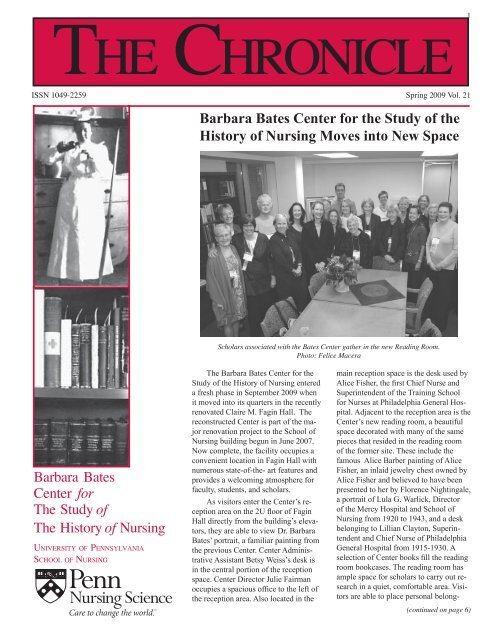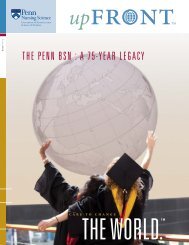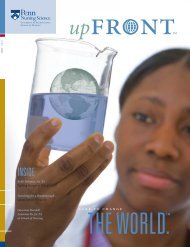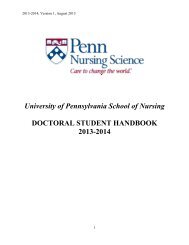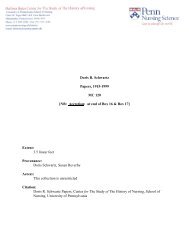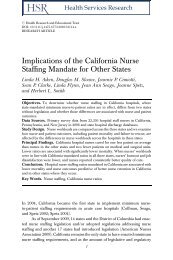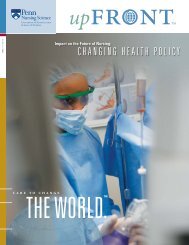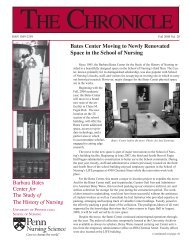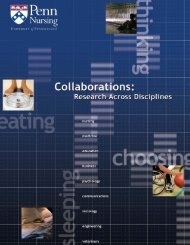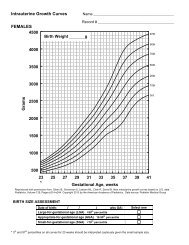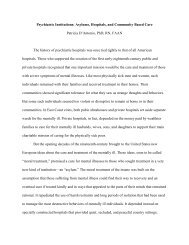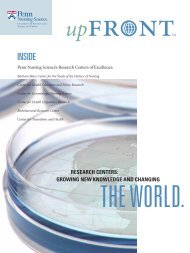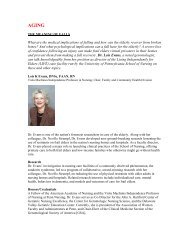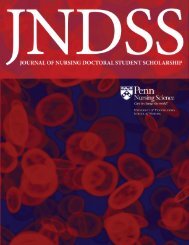Barbara Bates Center for the Study of the History of Nursing Moves ...
Barbara Bates Center for the Study of the History of Nursing Moves ...
Barbara Bates Center for the Study of the History of Nursing Moves ...
Create successful ePaper yourself
Turn your PDF publications into a flip-book with our unique Google optimized e-Paper software.
1<br />
ISSN 1049-2259<br />
Spring 2009 Vol. 21<br />
<strong>Barbara</strong> <strong>Bates</strong> <strong>Center</strong> <strong>for</strong> <strong>the</strong> <strong>Study</strong> <strong>of</strong> <strong>the</strong><br />
<strong>History</strong> <strong>of</strong> <strong>Nursing</strong> <strong>Moves</strong> into New Space<br />
Scholars associated with <strong>the</strong> <strong>Bates</strong> <strong>Center</strong> ga<strong>the</strong>r in <strong>the</strong> new Reading Room.<br />
Photo: Felice Macera<br />
The <strong>Barbara</strong> <strong>Bates</strong> <strong>Center</strong> <strong>for</strong> <strong>the</strong><br />
<strong>Study</strong> <strong>of</strong> <strong>the</strong> <strong>History</strong> <strong>of</strong> <strong>Nursing</strong> entered<br />
a fresh phase in September 2009 when<br />
it moved into its quarters in <strong>the</strong> recently<br />
renovated Claire M. Fagin Hall. The<br />
reconstructed <strong>Center</strong> is part <strong>of</strong> <strong>the</strong> major<br />
renovation project to <strong>the</strong> School <strong>of</strong><br />
<strong>Nursing</strong> building begun in June 2007.<br />
Now complete, <strong>the</strong> facility occupies a<br />
convenient location in Fagin Hall with<br />
numerous state-<strong>of</strong>-<strong>the</strong>- art features and<br />
provides a welcoming atmosphere <strong>for</strong><br />
faculty, students, and scholars.<br />
As visitors enter <strong>the</strong> <strong>Center</strong>’s reception<br />
area on <strong>the</strong> 2U floor <strong>of</strong> Fagin<br />
Hall directly from <strong>the</strong> building’s elevators,<br />
<strong>the</strong>y are able to view Dr. <strong>Barbara</strong><br />
<strong>Bates</strong>’ portrait, a familiar painting from<br />
<strong>the</strong> previous <strong>Center</strong>. <strong>Center</strong> Administrative<br />
Assistant Betsy Weiss’s desk is<br />
in <strong>the</strong> central portion <strong>of</strong> <strong>the</strong> reception<br />
space. <strong>Center</strong> Director Julie Fairman<br />
occupies a spacious <strong>of</strong>fice to <strong>the</strong> left <strong>of</strong><br />
<strong>the</strong> reception area. Also located in <strong>the</strong><br />
main reception space is <strong>the</strong> desk used by<br />
Alice Fisher, <strong>the</strong> first Chief Nurse and<br />
Superintendent <strong>of</strong> <strong>the</strong> Training School<br />
<strong>for</strong> Nurses at Philadelphia General Hospital.<br />
Adjacent to <strong>the</strong> reception area is <strong>the</strong><br />
<strong>Center</strong>’s new reading room, a beautiful<br />
space decorated with many <strong>of</strong> <strong>the</strong> same<br />
pieces that resided in <strong>the</strong> reading room<br />
<strong>of</strong> <strong>the</strong> <strong>for</strong>mer site. These include <strong>the</strong><br />
famous Alice Barber painting <strong>of</strong> Alice<br />
Fisher, an inlaid jewelry chest owned by<br />
Alice Fisher and believed to have been<br />
presented to her by Florence Nightingale,<br />
a portrait <strong>of</strong> Lula G. Warlick, Director<br />
<strong>of</strong> <strong>the</strong> Mercy Hospital and School <strong>of</strong><br />
<strong>Nursing</strong> from 1920 to 1943, and a desk<br />
belonging to Lillian Clayton, Superintendent<br />
and Chief Nurse <strong>of</strong> Philadelphia<br />
General Hospital from 1915-1930. A<br />
selection <strong>of</strong> <strong>Center</strong> books fill <strong>the</strong> reading<br />
room bookcases. The reading room has<br />
ample space <strong>for</strong> scholars to carry out research<br />
in a quiet, com<strong>for</strong>table area. Visitors<br />
are able to place personal belong-<br />
(continued on page 6)
2<br />
<strong>Barbara</strong> <strong>Bates</strong> <strong>Center</strong> <strong>for</strong><br />
The <strong>Study</strong> <strong>of</strong> The <strong>History</strong><br />
<strong>of</strong> <strong>Nursing</strong><br />
The <strong>Barbara</strong> <strong>Bates</strong> <strong>Center</strong> <strong>for</strong> The <strong>Study</strong> <strong>of</strong><br />
The <strong>History</strong> <strong>of</strong> <strong>Nursing</strong> was established in<br />
1985 to encourage and facilitate historical<br />
scholarship on health care history and nursing<br />
in <strong>the</strong> United States. Part <strong>of</strong> <strong>the</strong> <strong>Center</strong>’s<br />
mission is to maintain resources <strong>for</strong> research<br />
to improve <strong>the</strong> quality and scope <strong>of</strong> historical<br />
scholarship on nursing; and to disseminate<br />
new knowledge on nursing history through<br />
education, conferences, publications, and<br />
inter-disciplinary collaboration.<br />
Current projects at <strong>the</strong> <strong>Center</strong> include studies<br />
<strong>of</strong> <strong>the</strong> role <strong>of</strong> nurses in health care, <strong>the</strong> history<br />
<strong>of</strong> hospitals, <strong>the</strong> <strong>for</strong>ces shaping children’s<br />
health care delivery, <strong>the</strong> nursing work<strong>for</strong>ce<br />
and <strong>the</strong> construction <strong>of</strong> nurses’ personal and<br />
pr<strong>of</strong>essional lives. The <strong>Center</strong> also continues<br />
to collect, process, and catalogue an outstanding<br />
collection <strong>of</strong> primary historical materials.<br />
<strong>Center</strong> Hours are Monday through Friday,<br />
9:00 am. to 5:00 pm. Scholars planning to<br />
conduct research at <strong>the</strong> <strong>Center</strong> should contact<br />
<strong>the</strong> <strong>Center</strong>’s curator at 215-898-4502 or email<br />
Betsy Weiss at ehweiss@nursing.upenn.edu.<br />
Our curator will respond with a description <strong>of</strong><br />
<strong>the</strong> scope and content <strong>of</strong> relevant materials in<br />
<strong>the</strong> various collections.<br />
<strong>Center</strong> Advisory Board<br />
Ellen D. Baer, Chair<br />
M. Louise Fitzpatrick, Vice Chair<br />
Lillian Sholtis Brunner<br />
Dorothy del Bueno<br />
Hannah Henderson<br />
Jeanne Kiefner<br />
Ann P. Knight<br />
Nadine Landis<br />
Susan Lindee<br />
Mark Frazier Lloyd<br />
Marian Matez<br />
Rosalyn Watts<br />
<strong>Center</strong> Staff<br />
Julie Fairman, PhD, RN, FAAN<br />
Director<br />
Patricia D’Antonio, PhD, RN, FAAN<br />
Barbra Mann Wall, PhD, RN<br />
Associate Directors<br />
Karen Buhler-Wilkerson, PhD, RN, FAAN<br />
Joan E. Lynaugh, PhD, RN, FAAN<br />
Directors Emerita<br />
Cynthia Connolly, PhD, RN<br />
Julie Solchaski, PhD, RN, FAAN<br />
Fellows<br />
Jean C. Whelan, PhD, RN<br />
Special Projects Director<br />
Gail E. Farr, MA, CA<br />
Curator<br />
Betsy Weiss, Administrative Assistant<br />
Rita Beatty, Volunteer<br />
News from <strong>the</strong> <strong>Center</strong><br />
Pr<strong>of</strong>essor Julie Fairman<br />
<strong>Bates</strong> <strong>Center</strong> Director<br />
Julie Fairman<br />
Promoted to Pr<strong>of</strong>essor<br />
In December 2008, Dean Afaf Meleis<br />
announced <strong>the</strong> promotion <strong>of</strong> <strong>Center</strong><br />
Director Julie Fairman to <strong>the</strong> rank <strong>of</strong><br />
Pr<strong>of</strong>essor <strong>of</strong> <strong>Nursing</strong>. As was noted by<br />
Dean Meleis in <strong>the</strong> announcement message:<br />
“Dr. Fairman developed an internationally<br />
recognized program <strong>of</strong> scholarship<br />
related to <strong>the</strong> history <strong>of</strong> nursing.<br />
Her scholarly achievements in <strong>the</strong> area<br />
<strong>of</strong> nursing history have had an enormous<br />
impact on <strong>the</strong> field <strong>of</strong> understanding <strong>the</strong><br />
history <strong>of</strong> health care and health policy<br />
after World War II. Her data-based research<br />
contributes new knowledge and<br />
positions nurses as influential participants<br />
in <strong>the</strong> negotiation <strong>of</strong> clinical space<br />
and authority, <strong>the</strong> shaping and dissemination<br />
<strong>of</strong> technology, and as a critical perspective<br />
in <strong>the</strong> history <strong>of</strong> medicine. In<br />
2004, she was awarded <strong>the</strong> Agnes Dillon<br />
Randolf Award <strong>for</strong> Significant Contributions<br />
to <strong>the</strong> Field <strong>of</strong> <strong>Nursing</strong> <strong>History</strong><br />
from <strong>the</strong> University <strong>of</strong> Virginia.<br />
Dr. Fairman is a superb disseminator<br />
<strong>of</strong> her analyses and findings. She<br />
has authored two books: Critical Care<br />
<strong>Nursing</strong>: A <strong>History</strong> (1998) which was<br />
awarded <strong>the</strong> American Association <strong>for</strong><br />
<strong>the</strong> <strong>History</strong> <strong>of</strong> <strong>Nursing</strong>’s Lavinia L. Dock<br />
Award, <strong>the</strong> year it was published; and<br />
Making Room in <strong>the</strong> Clinic: American<br />
Nurse Practitioners and <strong>the</strong> Evolution<br />
<strong>of</strong> Modern Health Care (2008). She is<br />
embarking on her third book focusing<br />
on <strong>the</strong> role <strong>of</strong> nurses in <strong>the</strong> evolution <strong>of</strong><br />
health care by providing an historical<br />
overview and critique <strong>of</strong> American nursing<br />
from 1975 to <strong>the</strong> present.<br />
This May Dr. Fairman will receive<br />
<strong>the</strong> Dean’s Award <strong>for</strong> Exemplary Teaching<br />
– <strong>for</strong> which she was nominated by<br />
<strong>the</strong> entire Doctoral Student Organiation<br />
Board and by o<strong>the</strong>rs <strong>for</strong> her enduring<br />
impact on her students as future nursing<br />
scholars. Her extraordinary skills have<br />
also been recognized through <strong>the</strong> receipt<br />
<strong>of</strong> <strong>the</strong> Lindback Award <strong>for</strong> Distinguished<br />
Teaching (in 2007), and <strong>the</strong> <strong>Barbara</strong><br />
Lowery Doctoral Student Organization<br />
Faculty Award <strong>for</strong> Teaching (in 2003).<br />
She is an outstanding mentor and<br />
receives comments about her coaching<br />
and role modeling that are consistently<br />
couched in accolades.<br />
In addition to her scholarly contribution<br />
Julie Fairman is a gifted and<br />
inspiring member <strong>of</strong> her division, school<br />
and University, having made significant<br />
contributions throughout her career. She<br />
holds an administrative appointment as<br />
Director <strong>of</strong> The <strong>Barbara</strong> <strong>Bates</strong> <strong>Center</strong><br />
<strong>for</strong> <strong>the</strong> <strong>Study</strong> <strong>of</strong> <strong>the</strong> <strong>History</strong> <strong>of</strong> <strong>Nursing</strong>,<br />
an internationally-recognized historical<br />
research center. Within <strong>the</strong> School<br />
<strong>of</strong> <strong>Nursing</strong>, Dr. Fairman has served on<br />
numerous committees including chairing<br />
<strong>the</strong> Doctoral Admissions, Doctoral<br />
Curriculum and Doctoral Progressions<br />
committees during <strong>the</strong> 2005 to 2007<br />
academic years; and was <strong>the</strong> first faculty<br />
member elected to chair <strong>the</strong> Faculty Senate<br />
(in 2003-2004). At <strong>the</strong> University<br />
level, Dr. Fairman has been an active<br />
and contributing member <strong>of</strong> a number <strong>of</strong><br />
committees including most recently <strong>the</strong><br />
Senate Committee on Faculty and <strong>the</strong><br />
Administration.”<br />
Congratulations Julie on this tremendous<br />
and well deserved achievement.<br />
Grants<br />
In August, 2008 Dr. Barbra Mann<br />
Wall received a National Library <strong>of</strong><br />
Medicine Grant <strong>for</strong> her upcoming study,<br />
A Comparative <strong>History</strong> <strong>of</strong> Twentieth-<br />
Century Catholic Hospitals. Dr. Wall’s<br />
investigation researches <strong>the</strong> history <strong>of</strong><br />
Catholic hospitals from 1925 to 2000
through <strong>the</strong> lens <strong>of</strong> four religious nursing<br />
congregations, with special reference to<br />
how religious institutions such as hospitals<br />
attempt to shape social policies in a<br />
pluralistic environment. The end result<br />
will be a full-length book manuscript<br />
that will be <strong>of</strong> great interest to scholars<br />
<strong>of</strong> history, nursing, medicine, religion,<br />
gender, immigration, and labor, as well<br />
as to policy strategists. The central problem<br />
<strong>the</strong> book explores is how Catholic<br />
hospitals have been simultaneously<br />
religious and secular institutions. It will<br />
examine <strong>the</strong> ways in which that paradox<br />
has manifested itself over <strong>the</strong> course<br />
<strong>of</strong> <strong>the</strong> 20 th century, when market influences<br />
increasingly shaped medicine and<br />
healthcare.<br />
Dr. <strong>Barbara</strong> Mann Wall also received<br />
a 2008 Eastern <strong>Nursing</strong> Research<br />
Society/American Nurses Foundation<br />
Award <strong>for</strong> When Disaster Strikes: Nurses<br />
on <strong>the</strong> Front Lines, 1900-2001.<br />
Dr. Julie Fairman continues her Investigator<br />
Award in Health Policy from<br />
<strong>the</strong> Robert Wood Johnson Foundation,<br />
Practice Politics: The <strong>History</strong> <strong>of</strong> Nurse<br />
Practitioners, 1975 to <strong>the</strong> Present.<br />
Dr. Patricia D’Antonio received a<br />
$20,000 grant to support visiting Pr<strong>of</strong>essor<br />
Maria Elena Medina-Mora <strong>of</strong> Mexico<br />
as part <strong>of</strong> <strong>the</strong> 2009-2010 University’s<br />
Provost’s Distinguished International<br />
Scholars Program. Dr. D’Antonio continues<br />
work on her 2008-2009 National Endowment<br />
<strong>for</strong> <strong>the</strong> Humanities Fellowship,<br />
American <strong>Nursing</strong>: Neighborhood Work<br />
and National Mission.<br />
Dr. Jean Whelan continues her<br />
National Institute <strong>of</strong> Health, National<br />
Library <strong>of</strong> Medicine Scholarly Work in<br />
Biomedicine and Health Grant, Never<br />
Enough: Supply and Demand <strong>of</strong> Nurses,<br />
1900-1965.<br />
Drs. Karen Buhler-Wilkerson and<br />
Jean Whelan continue <strong>the</strong>ir National<br />
Institute <strong>of</strong> Health, National Library <strong>of</strong><br />
Medicine Scholarly Work in Biomedicine<br />
and Health Grant <strong>Nursing</strong>, <strong>History</strong><br />
and Healthcare: A Website.<br />
Dr. Julie Sochalski is a co-investigator<br />
on a NIH/NHLBI grant, Market<br />
Competition and <strong>the</strong> Quality <strong>of</strong> Home<br />
Health Services.<br />
Dr. Jennifer Hobbs began a VA<br />
Post-Doctoral Nurse Fellowship from<br />
<strong>the</strong> Department <strong>of</strong> Veteran Affairs. The<br />
title <strong>of</strong> her study is Standardizing <strong>the</strong><br />
Particular: The Development <strong>of</strong> Clinical<br />
<strong>Barbara</strong> Mann Wall on Penn’s Campus.<br />
Photo: Ira Joel Sartorius<br />
Guidelines in <strong>Nursing</strong>, 1970-1990.<br />
Dr. J. Margo Brooks Carthon<br />
began a joint post-doctoral fellowship<br />
with <strong>the</strong> <strong>Center</strong> <strong>for</strong> Health Outcomes and<br />
Policy Research and <strong>the</strong> <strong>Barbara</strong> <strong>Bates</strong><br />
<strong>Center</strong> <strong>for</strong> <strong>the</strong> <strong>Study</strong> <strong>of</strong> <strong>the</strong> <strong>History</strong> <strong>of</strong><br />
<strong>Nursing</strong>.<br />
Doctoral student Jonathan Gilbride<br />
received a Xi Chapter, Sigma Theta Tau<br />
Research Award <strong>for</strong> his study, <strong>Nursing</strong><br />
and <strong>the</strong> Politics <strong>of</strong> American Health<br />
Care, 1985-1995.<br />
Doctoral student Winifred Connerton<br />
received <strong>the</strong> 2008 American Association<br />
<strong>of</strong> <strong>the</strong> <strong>History</strong> <strong>of</strong> <strong>Nursing</strong>, H31 Pre-<br />
Doctoral Research Grant <strong>for</strong> her study,<br />
Have Cap, Will Travel; U.S. Nurses<br />
Abroad 1898-1939. Ms. Connerton also<br />
received a 2008 Xi Chapter, Sigma Theta<br />
Tau Research Award <strong>for</strong> her study.<br />
Doctoral student Linda Maldonado<br />
received <strong>the</strong> 2009 Lear Fellowship <strong>for</strong><br />
her study, The Maternity Care Coalition:<br />
A Quest <strong>for</strong> Social Justice.<br />
Awards<br />
Dr. Patricia D’Antonio received<br />
<strong>the</strong> 2008 American Association <strong>for</strong> <strong>the</strong><br />
<strong>History</strong> <strong>of</strong> <strong>Nursing</strong> M. Adelaide Nut-<br />
3<br />
ting Award, <strong>for</strong> her article,<br />
“Nurses and Wives and Mo<strong>the</strong>rs:<br />
Women and <strong>the</strong> Latter Day<br />
Saints Training School’s Class<br />
<strong>of</strong> 1919,” Journal <strong>of</strong> Women’s<br />
<strong>History</strong>, 19:3 (2007): 112-136<br />
Dr. Cynthia Connolly was<br />
awarded <strong>the</strong> 2008 American<br />
Association <strong>for</strong> <strong>the</strong> <strong>History</strong><br />
<strong>of</strong> <strong>Nursing</strong> Lavinia L. Dock<br />
Award, <strong>for</strong> her book, Saving<br />
Sickly Children: The Tuberculosis<br />
Preventorium in American<br />
Life, 1909-1970. New Brunswick,<br />
NJ.: Rutgers University<br />
Press.<br />
Dr. Jennifer Hobbs received<br />
<strong>the</strong> 2008 American<br />
Association <strong>for</strong> <strong>the</strong> <strong>History</strong> <strong>of</strong><br />
<strong>Nursing</strong> Theresa E. Christy<br />
Award <strong>for</strong> her dissertation,<br />
Naming Power: A Historical<br />
Analysis <strong>of</strong> Clinical In<strong>for</strong>mation<br />
Systems, 1970-1990.<br />
Publications<br />
Ellen Baer. Zula Mae Barber<br />
Bice Memorial Lecture. “ ‘Do<br />
trained nurses ...work <strong>for</strong> love, or do<br />
<strong>the</strong>y work <strong>for</strong> money?’ <strong>Nursing</strong> and altruism<br />
in <strong>the</strong> twenty-first century.” <strong>Nursing</strong><br />
<strong>History</strong> Review, 17 (2009): 28-46.<br />
Julie Fairman and Patricia<br />
D’Antonio. “Reimagining nursing’s<br />
place in <strong>the</strong> history <strong>of</strong> clinical practice.”<br />
Journal <strong>of</strong> <strong>the</strong> <strong>History</strong> <strong>of</strong> Medicine and<br />
Allied Sciences, 63:4 (2008): 435-446.<br />
Barbra Mann Wall. “Healing after<br />
disasters in early twentieth-century Texas.”<br />
Advances in <strong>Nursing</strong> Science, 31:3<br />
(2008): 211-224.<br />
Barbra Mann Wall. “Twenty-five<br />
years <strong>of</strong> historical scholarship.” Pennsylvania<br />
Nurse, 63:2 (2008): 10-12.<br />
Barbra Mann Wall. “Looking<br />
back: Celebrating nursing history.”<br />
American Journal <strong>of</strong> <strong>Nursing</strong>, 108:6<br />
(June 2008): 26-29.<br />
Christopher R. Friese, Eileen T.<br />
Lake, Linda H. Aiken, Jeffrey H.Silber,<br />
Julie Sochalski, “Hospital nurse practice<br />
environments and outcomes <strong>for</strong> surgical<br />
oncology patients.” Health Services Research,<br />
43:4 (2008): 1145-1163.<br />
Anne Sales, Nancy Sharp, Yu-Fang<br />
Li, Elliott Lowy, Gwendolyn Greiner,<br />
(continued on page 4)
4<br />
<strong>Bates</strong> <strong>Nursing</strong> <strong>History</strong> <strong>Center</strong> Welcomes New Faculty Member<br />
This past September, one <strong>of</strong> our<br />
<strong>Bates</strong> <strong>Center</strong> graduates, Cynthia A. Connolly,<br />
PhD, RN, joined <strong>the</strong> School <strong>of</strong><br />
<strong>Nursing</strong> faculty as an Associate Pr<strong>of</strong>essor<br />
<strong>of</strong> <strong>Nursing</strong>. Dr. Connolly comes to<br />
<strong>the</strong> School <strong>of</strong> <strong>Nursing</strong> with an impressive<br />
resume. She was awarded a PhD in 1999<br />
and a Bachelors degree in 1980 from <strong>the</strong><br />
University <strong>of</strong> Pennsylvania, School <strong>of</strong><br />
<strong>Nursing</strong>, and received a masters degree<br />
in Primary Care and School Health from<br />
<strong>the</strong> University <strong>of</strong> Rochester in 1987. Dr.<br />
Connolly completed a two year Postdoctoral<br />
Fellowship at Columbia University’s<br />
Joseph L. Mailman School <strong>of</strong> Public<br />
Health in 2003. Her postdoctoral training<br />
at Columbia was enhanced by a fellowship<br />
in <strong>the</strong> United States Senate with<br />
<strong>the</strong> late Senator Paul Wellstone [D-Minnesota].<br />
There, she placed contemporary<br />
health care issues into historical context<br />
<strong>for</strong> current legislative action. She joined<br />
Yale’s faculty in 2003 as an Assistant<br />
Pr<strong>of</strong>essor at <strong>the</strong> School <strong>of</strong> <strong>Nursing</strong> and<br />
in <strong>the</strong> <strong>History</strong> <strong>of</strong> Medicine program at<br />
<strong>the</strong> medical school. Prior to her appointment<br />
at Yale, and upon completion <strong>of</strong> her<br />
doctoral studies, Dr. Connolly taught at<br />
Penn <strong>Nursing</strong> first as a Lecturer <strong>the</strong>n as<br />
an Adjunct Assistant Pr<strong>of</strong>essor.<br />
Dr. Connolly has achieved national<br />
and international recognition <strong>for</strong> her<br />
research analyzing <strong>the</strong> <strong>for</strong>ces that have<br />
shaped children’s health care delivery<br />
and family policy in <strong>the</strong> United States.<br />
She is particularly interested in <strong>the</strong> evolution<br />
<strong>of</strong> pediatric medical and nursing<br />
practice as well as <strong>the</strong> way in which<br />
illness has been experienced over time<br />
by children and families. Her work provides<br />
insight into <strong>the</strong> intellectual foundations<br />
<strong>of</strong> nursing, particularly early twentieth<br />
century nursing care <strong>of</strong> children. It<br />
yields new in<strong>for</strong>mation concerning <strong>the</strong><br />
ways in which <strong>the</strong> identification and assessment<br />
<strong>of</strong> risk factors is highly culturally<br />
dependent and subject to <strong>the</strong> biases<br />
<strong>of</strong> <strong>the</strong> evaluators and <strong>of</strong> <strong>the</strong> predominant<br />
culture, and analyzes <strong>the</strong> legacy <strong>of</strong> past<br />
politics in current health and social welfare<br />
policies.<br />
Dr. Connolly recently completed a<br />
project focusing on a unique early twentieth<br />
century intervention, <strong>the</strong> preventorium.<br />
Her research on <strong>the</strong> tuberculosis<br />
preventorium was published in 2008 in<br />
her book: Saving Sickly Children: The<br />
Dr. Cynthia Connolly. Photo by Felice Macera<br />
Tuberculosis Preventorium in American<br />
Life, 1909–1970, which was awarded<br />
<strong>the</strong> 2008 prestigious Lavinia L. Dock<br />
Award <strong>for</strong> Exemplary Historical Research<br />
and Writing. Her current research<br />
project focuses on a history <strong>of</strong> children<br />
and <strong>the</strong> pharmaceutical industry in <strong>the</strong><br />
United States.<br />
Dr. Connolly has received high<br />
marks <strong>for</strong> teaching pre-pr<strong>of</strong>essional<br />
clinical courses in pediatric nursing,<br />
and <strong>for</strong> <strong>the</strong> integration <strong>of</strong> nursing history<br />
in masters and doctoral courses. Of<br />
note, she was <strong>the</strong> first member <strong>of</strong> Yale’s<br />
School <strong>of</strong> <strong>Nursing</strong> to develop and teach<br />
an interdisciplinary course on children’s<br />
health in <strong>the</strong> United States, 1800-2000.<br />
Forty-five Yale students from different<br />
departments competed <strong>for</strong> 15 spots in<br />
this course. At Penn, Dr. Connolly will<br />
teach undergraduate pediatrics. Welcome<br />
back to Penn Dr. Connolly!<br />
(News from <strong>the</strong> <strong>Center</strong>, continued)<br />
Chuan-Fen Liu, Anna Alt-White, RN,<br />
Cathy Rick, Julie Sochalski, Pamela<br />
H. Mitchell, Gary Rosenthal, Cheryl<br />
Stetler, Paulette Cournoyer, Jack<br />
Needleman. “The association between<br />
nursing factors and patient mortality in<br />
<strong>the</strong> Veterans Health Administration.”<br />
Medical Care, 46:9 (2008): 938-945.<br />
Margaret Grey and Cynthia Connolly.<br />
“ ‘Coming toge<strong>the</strong>r, keeping<br />
toge<strong>the</strong>r, working toge<strong>the</strong>r’: Interdisciplinary<br />
research and nursing, past,<br />
present, future.” <strong>Nursing</strong> Outlook, 56:3<br />
(2008): 102-107.<br />
Jennifer Hobbs. “A dimensional<br />
analysis <strong>of</strong> patient-centered care, 2000-<br />
2006.” <strong>Nursing</strong> Research, 58 (January/<br />
February, 2009): 52-62.<br />
Mindy Zeitzer, J. Margo Brooks.<br />
“In <strong>the</strong> line <strong>of</strong> fire: Traumatic Brain injury<br />
among Iraq war veterans.” American<br />
Association <strong>of</strong> Occupational Health<br />
Nurses Journal, 56:8 (2008): 347-354.<br />
Salimah Meghani, and J. Margo<br />
Brooks. “Patient-provider race-concordance:<br />
Does it matter in improving<br />
minority patients’ health outcomes?”<br />
Ethnicity and Health, 14:1 (2009): 107-<br />
30.<br />
A New Book<br />
Saving Sickly Children: The Tuberculosis<br />
Preventorium in American Life,<br />
1909–1970, (Rutgers University Press,<br />
2008) by University <strong>of</strong> Pennsylvania<br />
School <strong>of</strong> <strong>Nursing</strong> Associate Pr<strong>of</strong>essor<br />
Cynthia Connolly (see opposite)<br />
traces <strong>the</strong> rise and fall <strong>of</strong> a distinctive<br />
American institution, <strong>the</strong> tuberculosis<br />
preventorium. This book is an outgrowth<br />
<strong>of</strong> Dr. Connolly’s doctoral dissertation,<br />
“Prevention Through Detention: The<br />
Pediatric Tuberculosis Preventorium<br />
Movement in <strong>the</strong> United States, 1909-<br />
1951” which she completed here at<br />
Penn in 1999, and is based on research
New Book by Cynthia Connolly<br />
third <strong>of</strong> <strong>the</strong> twentieth century. During<br />
this period, it was widely recognized that<br />
African Americans suffered from poorer<br />
health and died at higher rates from<br />
infectious disease such as tuberculosis.<br />
The study aimed to unravel <strong>the</strong> complex<br />
social and environmental dynamics that<br />
resulted in this phenomenon.<br />
By <strong>the</strong> turn <strong>of</strong> <strong>the</strong> twentieth century,<br />
Philadelphia was renowned <strong>for</strong> its<br />
civically active black community. After<br />
<strong>the</strong> Civil War, <strong>the</strong> city was a hub <strong>for</strong><br />
many newly arriving African American<br />
sou<strong>the</strong>rn migrants. The large influx <strong>of</strong><br />
migrants taxed <strong>the</strong> city’s already strained<br />
Bureau <strong>of</strong> Health, leaving much <strong>of</strong> <strong>the</strong><br />
health care <strong>of</strong> African American residents<br />
to community networks existing<br />
in <strong>the</strong> black community and <strong>the</strong> private<br />
sector.<br />
Private civic associations such as<br />
<strong>the</strong> Starr Centre, <strong>the</strong> Whittier Centre, and<br />
<strong>the</strong> Phipps Institute actively worked with<br />
African American residents to improve<br />
living conditions and increase health<br />
services in <strong>the</strong> black community. Themes<br />
<strong>of</strong> racial, economic, and social inequality<br />
emerge in <strong>the</strong> study as African American<br />
residents grappled with stark inequalities<br />
in health care, shrinking labor<br />
opportunities, and inadequate housing.<br />
The study examines fundamental similarities<br />
and differences in <strong>the</strong> approaches<br />
<strong>of</strong> key civic activists and organizations<br />
addressing <strong>the</strong>se pressing concerns. Private<br />
sector-community liaisons became<br />
a defining feature <strong>of</strong> heath service proviin<br />
primary source materials at <strong>the</strong> <strong>Bates</strong><br />
<strong>Center</strong> and o<strong>the</strong>r repositories. The preventorium<br />
as an institution has not been<br />
widely studied. However, during <strong>the</strong><br />
heyday <strong>of</strong> <strong>the</strong> preventorium movement,<br />
<strong>the</strong> institutions provided care to thousands<br />
<strong>of</strong> children throughout <strong>the</strong> United<br />
States. Two institutions highlighted in<br />
<strong>the</strong> book <strong>of</strong> particular interest were <strong>the</strong><br />
Rest Haven Preventorium in San Diego<br />
and <strong>the</strong> Farmingdale Preventorium in<br />
New Jersey.<br />
The preventorium blended features<br />
<strong>of</strong> a hospital, sanatorium, and school,<br />
while endeavoring to imbue its patients<br />
with <strong>the</strong> values <strong>of</strong> an idealized middleclass<br />
home life. The institution did not<br />
treat sick children, but aimed to prevent<br />
TB in indigent youngsters considered<br />
to be “at risk.” The children typically<br />
hailed from families in which one or<br />
both parents suffered from <strong>the</strong> disease.<br />
They spent as much time as possible<br />
out <strong>of</strong> doors in camp-like settings where<br />
<strong>the</strong>y received <strong>the</strong>ir education, meals, and<br />
education.<br />
The preventorium was popular because<br />
it <strong>of</strong>fered something <strong>for</strong> everyone.<br />
When scientific revelations that most TB<br />
infection took place during <strong>the</strong> childhood<br />
years merged with <strong>the</strong> re<strong>for</strong>m-oriented,<br />
child-saving ethos <strong>of</strong> early twentiethcentury<br />
America, <strong>the</strong> invention <strong>of</strong> <strong>the</strong><br />
preventorium in 1909 seemed not just<br />
innovative, but necessary. Preventorium<br />
fundraising engendered little controversy<br />
and provided great visibility <strong>for</strong> newly<br />
founded antituberculosis organizations<br />
and <strong>for</strong> <strong>the</strong> nurses, physicians, and o<strong>the</strong>rs<br />
who supported <strong>the</strong>m. The institution<br />
addressed issues <strong>of</strong> poverty, neglect, and<br />
malnutrition in a discrete population,<br />
indigent children, who not only engendered<br />
great sympathy <strong>for</strong> <strong>the</strong>ir plight,<br />
but were also considered more easily<br />
influenced to change <strong>the</strong>ir behavior than<br />
adults. It emphasized environmental<br />
care and emphasis on “right” living. For<br />
those who worried about <strong>the</strong> growing influx<br />
<strong>of</strong> immigrants, and <strong>the</strong>ir potential to<br />
menace o<strong>the</strong>rs’ health and change American<br />
society, <strong>the</strong> institution addressed <strong>the</strong><br />
importance <strong>of</strong> a middle-class lifestyle,<br />
personal habits, diet, and values.<br />
The preventorium is emblematic <strong>of</strong> a<br />
time when pediatric health care and child<br />
welfare meshed. As a result, it provides<br />
an ideal vantage point from which to link<br />
<strong>the</strong> history <strong>of</strong> tuberculosis to that <strong>of</strong> child<br />
health and social welfare. The institution<br />
<strong>of</strong>fers important lessons to contemporary<br />
policymakers and clinicians as well. The<br />
preventorium represented a response to<br />
an enduring set <strong>of</strong> issues in American society:<br />
how best to care <strong>for</strong> those who are<br />
ill; who should provide that care; how<br />
should it be subsidized when people cannot<br />
af<strong>for</strong>d to pay <strong>for</strong> it <strong>the</strong>mselves; and<br />
how to respond to data that suggests that<br />
some groups <strong>of</strong> people experience illness<br />
at higher rates than o<strong>the</strong>rs. Preventorium<br />
nurses and doctors wrestled with concerns<br />
such as how best to help indigent<br />
families, what society “owes” children<br />
in terms <strong>of</strong> health and social welfare services,<br />
how much control parents should<br />
have over <strong>the</strong>ir own children, and who<br />
should decide what interventions are “in<br />
<strong>the</strong> best interest <strong>of</strong> <strong>the</strong> child.” The doors<br />
<strong>of</strong> <strong>the</strong> preventoria have long been<br />
shuttered and <strong>the</strong> institutions razed or<br />
converted <strong>for</strong> o<strong>the</strong>r uses, but <strong>the</strong> preventorium<br />
story is not over because <strong>the</strong><br />
dilemmas <strong>the</strong>ir walls housed endure into<br />
<strong>the</strong> twenty-first century, and we can learn<br />
from its successes and failures.<br />
Margo Brooks Carthon<br />
Receives Doctorate<br />
In October 2008, Margo Brooks<br />
Carthon successfully defended her<br />
doctoral dissertation, No Place <strong>for</strong> <strong>the</strong><br />
Dying: A Tale <strong>of</strong> Urban Health Work in<br />
Philadelphia’s Black Belt, 1900-1930.<br />
This study examines <strong>the</strong> poor health status<br />
<strong>of</strong> African Americans during <strong>the</strong> first<br />
(continued on page 7)<br />
Dr. J. Margo Brooks Carthon<br />
Photo: Ira Joel Sartorius<br />
5
6<br />
<strong>Bates</strong> <strong>Center</strong> Welcomes Two New Advisory<br />
Board members<br />
This past year two new members joined <strong>the</strong> <strong>Bates</strong> <strong>Nursing</strong> <strong>History</strong> <strong>Center</strong> Advisory<br />
Board. Dr. Dorothy del Bueno and Ms. Marion Matez are both well known to <strong>the</strong><br />
School <strong>of</strong> <strong>Nursing</strong> as well as to <strong>the</strong> Philadelphia area and are looking <strong>for</strong>ward to <strong>the</strong>ir<br />
new roles with <strong>the</strong> <strong>Center</strong>.<br />
Dr. Del Bueno has had a rich and varied pr<strong>of</strong>essional career. As a young woman,<br />
she left a position as an assistant bank manager to attend nursing school, graduating from<br />
<strong>the</strong> Philadelphia General Hospital in 1962. Between 1963 and 1975, Dr. del Bueno completed<br />
a baccalaureate, a masters and a doctoral degree while working in a variety <strong>of</strong> positions<br />
including staff nurse, night supervisor, instructor, and Director <strong>of</strong> Staff Education.<br />
Her doctoral dissertation was <strong>the</strong> first study to evaluate <strong>the</strong> effects <strong>of</strong> continuing education<br />
on subsequent clinical per<strong>for</strong>mance.<br />
The author <strong>of</strong> three books and 113 articles, she has traveled extensively in <strong>the</strong> United<br />
States Canada, New Zealand, and Australia as a lecturer and consultant. Well known <strong>for</strong><br />
her work in competency assessment, per<strong>for</strong>mance evaluation, and organizational politics,<br />
she has received numerous awards from pr<strong>of</strong>essional and educational organizations<br />
including <strong>the</strong> 2005 American Association <strong>of</strong> Critical Care Nurses Award <strong>for</strong> a Distinguished<br />
Career in <strong>Nursing</strong>.<br />
Dr. del Bueno has served on <strong>the</strong> board <strong>of</strong> directors and advisory boards <strong>for</strong> a variety<br />
<strong>of</strong> hospitals, educational services and pr<strong>of</strong>essional groups including: Presbyterian Hospital,<br />
Philadelphia, Concept Development, American Society <strong>for</strong> Health Manpower, Education<br />
& Training, Journal <strong>of</strong> <strong>Nursing</strong> Administration, Nurse Educator, American Network,<br />
RN Magazine and Moss Rehabilitation <strong>Center</strong>-lnternal Grants.<br />
Formerly <strong>the</strong> Assistant Dean <strong>for</strong> Continuing Education and Interim Chair <strong>for</strong> <strong>the</strong><br />
<strong>Nursing</strong> Administration program at <strong>the</strong> University <strong>of</strong> Pennsylvania, School <strong>of</strong> <strong>Nursing</strong><br />
Dr. del Bueno is currently <strong>the</strong> senior consultant and partner <strong>of</strong> Per<strong>for</strong>mance Management<br />
Services, Inc.<br />
Dr. del Bueno joined <strong>the</strong> Board to add her voice in support <strong>of</strong> <strong>the</strong> mission <strong>of</strong> <strong>the</strong><br />
<strong>Bates</strong> <strong>Center</strong> to ensure <strong>the</strong> generation <strong>of</strong> historical knowledge, scholarship, and research.<br />
Recognizing <strong>the</strong> vital nature <strong>of</strong> historical study to <strong>the</strong> development <strong>of</strong> <strong>the</strong> pr<strong>of</strong>ession, Dr.<br />
del Bueno is committed to advancing <strong>the</strong> goals <strong>of</strong> <strong>the</strong> <strong>Center</strong> as it meets challenges in <strong>the</strong><br />
coming years.<br />
The <strong>Center</strong> also welcomes, Marian Matez, our second new Board Member. Ms.<br />
Matez began her career here at <strong>the</strong> University <strong>of</strong> Pennsylvania where she received her<br />
Baccalaureate degree. After moving to Connecticut and earning a Master’s degree in Education,<br />
she worked in <strong>the</strong> Connecticut public school system where she wrote programs<br />
<strong>for</strong> <strong>the</strong> intellectually gifted and introduced a variety <strong>of</strong> media programs into <strong>the</strong> school<br />
library system. Much <strong>of</strong> her work initiated <strong>the</strong> trend to expand school libraries into media<br />
centers.<br />
After moving back to <strong>the</strong> Philadelphia area in <strong>the</strong> late 1970s, Ms. Matez met Claire<br />
Fagin, who recruited her to <strong>the</strong> School <strong>of</strong> <strong>Nursing</strong>. Ms. Matez worked as <strong>the</strong> Admissions<br />
<strong>of</strong>ficer charged by Dean Fagin with recruiting <strong>the</strong> “best and <strong>the</strong> brightest” to Penn <strong>Nursing</strong>.<br />
She remembers Dean Fagin telling her that her job was to get <strong>the</strong> best people to Penn<br />
and to change <strong>the</strong> image <strong>of</strong> nursing, which she did splendidly. To accomplish this goal<br />
Ms. Matez traveled extensively around <strong>the</strong> country recruiting students and educating <strong>the</strong><br />
public about <strong>the</strong> difference between nursing and medicine.<br />
Ms. Matez reports that “she loved her work at <strong>the</strong> School <strong>of</strong> <strong>Nursing</strong>,” meeting so<br />
many people who helped to shape her life. Recruited by Joan Lynaugh <strong>for</strong> <strong>the</strong> Board,<br />
Marion is looking <strong>for</strong>ward to her tenure as a Board member. She recognizes <strong>the</strong> importance<br />
<strong>of</strong> <strong>the</strong> <strong>Center</strong> maintaining a strong financial base and <strong>the</strong> need to ensure a stimulating<br />
atmosphere in which to generate creative ideas <strong>for</strong> <strong>the</strong> future <strong>of</strong> <strong>the</strong> <strong>Center</strong>. Marion<br />
Matez is most happy to renew her association with <strong>the</strong> School <strong>of</strong> <strong>Nursing</strong> and is eager to<br />
participate in advancing <strong>the</strong> goals <strong>of</strong> <strong>the</strong> <strong>Center</strong>.<br />
We welcome our new Board members and look <strong>for</strong>ward to a productive relationship.<br />
(New Space, continued)<br />
ings in secure lockers while engaged in<br />
research. The remainder <strong>of</strong> <strong>the</strong> reception<br />
space includes a lovely sitting area which<br />
is <strong>the</strong> new home to <strong>the</strong> Alumnae Association<br />
<strong>of</strong> <strong>the</strong> Hospital <strong>of</strong> <strong>the</strong> University <strong>of</strong><br />
Pennsylvania’s grandfa<strong>the</strong>r clock. There<br />
is also a small kitchen facility and an<br />
<strong>of</strong>fice/workroom suitable <strong>for</strong> use by students<br />
and visiting scholars adjoining <strong>the</strong><br />
main reception area.<br />
The <strong>of</strong>fice wing <strong>of</strong> <strong>the</strong> <strong>Center</strong> contains<br />
a conference room, faculty and<br />
staff <strong>of</strong>fices, collection storage space and<br />
<strong>the</strong> <strong>of</strong>fice <strong>of</strong> <strong>the</strong> Alumni Association <strong>of</strong><br />
<strong>the</strong> School <strong>of</strong> <strong>Nursing</strong> <strong>of</strong> <strong>the</strong> Hospital<br />
<strong>of</strong> <strong>the</strong> University <strong>of</strong> Pennsylvania. The<br />
conference room features up-to-date<br />
audiovisual technology appropriate to<br />
<strong>the</strong> <strong>Center</strong>’s seminar and meeting needs.<br />
Faculty <strong>of</strong>fices are bright and cheery,<br />
af<strong>for</strong>ding sufficient space <strong>for</strong> faculty to<br />
work and conference with students. Curator<br />
Gail Farr’s <strong>of</strong>fice is also located in<br />
<strong>the</strong> <strong>of</strong>fice wing. Several <strong>of</strong> <strong>the</strong> <strong>Center</strong>’s<br />
pictures hang on <strong>the</strong> corridor walls, adding<br />
to <strong>the</strong> sense <strong>of</strong> <strong>the</strong> rich history <strong>of</strong> <strong>the</strong><br />
School. Although a thoroughly modern<br />
space in which to work, <strong>the</strong> newly<br />
re-furbished <strong>History</strong> <strong>Center</strong> creates an<br />
historical atmosphere appropriate to <strong>the</strong><br />
<strong>Center</strong>’s mission.<br />
After <strong>the</strong> year-long renovation process,<br />
<strong>Center</strong> faculty, staff, and students<br />
are happy to be back in Fagin Hall and<br />
are particularly pleased to occupy such<br />
a wonderful space. Having <strong>the</strong> <strong>Center</strong>’s<br />
collections, faculty <strong>of</strong>fices, and meeting<br />
spaces in a contiguous area enables<br />
<strong>the</strong> work <strong>of</strong> <strong>the</strong> <strong>Center</strong> to proceed in an<br />
efficient, collegial manner. As well, <strong>the</strong><br />
space enables <strong>the</strong> <strong>Center</strong> to accommodate<br />
a number <strong>of</strong> visiting scholars at one<br />
time. To date, scholars have been well<br />
pleased with <strong>the</strong> changes made.<br />
On October 30, 2008, <strong>the</strong> <strong>Bates</strong> <strong>Center</strong><br />
took part in <strong>the</strong> <strong>of</strong>ficial open house<br />
<strong>for</strong> <strong>the</strong> renovated Fagin Hall. Guests<br />
were delighted with <strong>the</strong> improvements to<br />
<strong>the</strong> school building and quite impressed<br />
with <strong>the</strong> new look <strong>of</strong> <strong>the</strong> <strong>Bates</strong> <strong>Center</strong>.<br />
We invite everyone to visit <strong>the</strong> renovated<br />
<strong>Center</strong>. For fur<strong>the</strong>r in<strong>for</strong>mation contact<br />
Betsy Weiss at ehweiss@nursing.upenn.<br />
edu or 215-898-4502.
has added much to historical<br />
scholarship and our understanding<br />
<strong>of</strong> health disparities.<br />
<strong>Bates</strong> <strong>Center</strong> Hosts<br />
Visiting Scholar<br />
from China<br />
In September 2008, <strong>the</strong><br />
<strong>Bates</strong> <strong>Center</strong> was delighted<br />
to welcome visiting scholar<br />
Jing Li (Lisa), a doctoral<br />
student from <strong>the</strong> Second<br />
Military Medical University<br />
in Shanghai, China. Lisa<br />
traveled to <strong>the</strong> United States<br />
and specifically to <strong>the</strong><br />
University <strong>of</strong> Pennsylvania<br />
to study <strong>the</strong> methodology<br />
<strong>of</strong> history and <strong>the</strong> history <strong>of</strong><br />
nursing in <strong>the</strong> U.S.<br />
Lisa holds a Masters <strong>of</strong><br />
Medicine degree from Peking<br />
Jing Li (Lisa) and Dr. Julie Fairman meet in Dr. Fairman’s <strong>of</strong>fice. Photo: Michelle Holshue.<br />
University in Beijing and is<br />
(Carthon, continued)<br />
American communities.<br />
an Associate Pr<strong>of</strong>essor at <strong>the</strong><br />
sion <strong>for</strong> African American residents during<br />
this period and served as one <strong>of</strong> <strong>the</strong> dissertation, Dr. Brooks Carthon began She is a prolific author having published<br />
Following <strong>the</strong> completion <strong>of</strong> her Shandong University School <strong>of</strong> <strong>Nursing</strong>.<br />
cornerstones <strong>for</strong> community organizers a joint post-doctoral appointment at <strong>the</strong> eight papers in premier nursing journals<br />
who sought improved standards <strong>of</strong> living <strong>Center</strong> <strong>for</strong> Health Outcomes and Policy in China including <strong>the</strong> Chinese Journal<br />
<strong>for</strong> <strong>the</strong> black community.<br />
Research (CHOPR) and <strong>the</strong> <strong>Barbara</strong> <strong>Bates</strong> <strong>of</strong> <strong>Nursing</strong>, <strong>the</strong> Journal <strong>of</strong> <strong>Nursing</strong><br />
<strong>Center</strong> <strong>for</strong> <strong>the</strong> <strong>Study</strong> <strong>of</strong> <strong>the</strong> <strong>History</strong> <strong>of</strong> Science, and <strong>the</strong> Journal <strong>of</strong> Nurses<br />
Dr. Carthon’s dissertation represents<br />
<strong>Nursing</strong> at <strong>the</strong> University <strong>of</strong> Pennsylvania Training. She has also contributed<br />
a groundbreaking study on a previously<br />
School Of <strong>Nursing</strong>. The focus <strong>of</strong> her postdoctoral<br />
studies is to fur<strong>the</strong>r examine dif-<br />
Director on two research projects, one<br />
to several books. She was a Project<br />
under-investigated topic <strong>of</strong> critical importance<br />
to <strong>the</strong> nation’s health. The results<br />
<strong>of</strong> her study illuminate <strong>the</strong> little unferentials<br />
in minority health outcomes by examining <strong>the</strong> relationship between<br />
examining <strong>the</strong> characteristics <strong>of</strong> hospital self-efficacy and rehabilitation outcomes<br />
derstood historical background <strong>of</strong> racial<br />
organizations and <strong>the</strong> influence <strong>of</strong> nursing among stroke patients, and <strong>the</strong> o<strong>the</strong>r on<br />
health disparities and will prove useful to<br />
care on minority health outcomes.<br />
utilization <strong>of</strong> nursing students.<br />
researchers and policy makers striving to<br />
ameliorate health differentials in African Congratulations to Dr. Carthon on<br />
completing this impressive study which<br />
7<br />
Membership Application to <strong>the</strong> <strong>Barbara</strong> <strong>Bates</strong> <strong>Center</strong> <strong>for</strong> The <strong>Study</strong> <strong>of</strong> The <strong>History</strong> <strong>of</strong> <strong>Nursing</strong><br />
I would like to make a donation <strong>of</strong> $<br />
; Please enroll me in <strong>the</strong> following group:<br />
___Friends <strong>of</strong> <strong>the</strong> <strong>Center</strong> (Up to $50) ___Lillian Wald Society ($250 to $499)<br />
___<strong>Center</strong> Contributor ($50 to $99) ___Alice Fisher Society ($500 to $999)<br />
___Linda Richards Society ($100 to $249)<br />
___Nightingale Society ($1,000 and Up)<br />
My Check is enclosed. Make checks payable to <strong>the</strong> Trustees <strong>of</strong> <strong>the</strong> University <strong>of</strong> Pennsylvania.<br />
___Charge my ___MasterCard ___Visa ___American Express Expiration Date______________<br />
___Card No.<br />
Signature X___________________________________<br />
Please send me more in<strong>for</strong>mation about: ___Named gift opportunities ___Making a bequest to <strong>the</strong> <strong>Center</strong><br />
NAME<br />
ADDRESS<br />
CITY STATE ZIP<br />
Your contribution is tax deductible. Thank you.
While Lisa’s previous scholarship<br />
focused upon student clinical competency,<br />
nursing pedagogy, and geriatric<br />
dementia nursing, her doctoral dissertation<br />
research topic is on <strong>the</strong> history <strong>of</strong><br />
nursing. Lisa was awarded a prestigious<br />
scholarship from Shandong University<br />
and <strong>the</strong> China Scholarship Council in<br />
partial support <strong>of</strong> her studies while here.<br />
She is working under <strong>the</strong> mentorship <strong>of</strong><br />
Dr. Julie Fairman. After she returns to<br />
China and completes her PhD studies,<br />
Lisa will join <strong>the</strong> faculty at <strong>the</strong> Shandong<br />
University School <strong>of</strong> <strong>Nursing</strong> in <strong>the</strong> Department<br />
<strong>of</strong> Women’s Health.<br />
Lisa describes her experience at <strong>the</strong><br />
<strong>Bates</strong> <strong>Center</strong> in this way:<br />
“Thanks <strong>for</strong> af<strong>for</strong>ding me this opportunity<br />
to conduct a historical study<br />
as a visiting scholar <strong>for</strong> a year in <strong>the</strong><br />
<strong>Barbara</strong> <strong>Bates</strong> <strong>Center</strong> <strong>for</strong> <strong>the</strong> <strong>Study</strong> <strong>of</strong><br />
<strong>the</strong> <strong>History</strong> <strong>of</strong> <strong>Nursing</strong> at <strong>the</strong> University<br />
<strong>of</strong> Pennsylvania. I have been deeply<br />
impressed by <strong>the</strong> scientific historical<br />
studies carried out at <strong>the</strong> <strong>Bates</strong> <strong>Center</strong>.<br />
When I arrived at <strong>the</strong> <strong>Center</strong> I received<br />
a warm welcome and invaluable instruction<br />
from <strong>the</strong> faculty. I am especially<br />
grateful to my mentor, Dr. Fairman,<br />
whose own outstanding work, scientific<br />
standards, and innumerable kindnesses<br />
have always shown me what it means to<br />
be a true scholar. My work here in <strong>the</strong><br />
United States is to explore <strong>the</strong> history<br />
<strong>of</strong> <strong>the</strong> specialization <strong>of</strong> nursing in China<br />
from 1949 to <strong>the</strong> present. So far, I have<br />
been busy examining materials I have<br />
retrieved from <strong>the</strong> database <strong>of</strong> <strong>the</strong> Chinese<br />
National Knowledge Infrastructure<br />
<strong>for</strong> <strong>the</strong> Chinese Journal <strong>of</strong> <strong>Nursing</strong> from<br />
1954 to 2008. My plan is to concentrate<br />
on examining mental health nursing and<br />
community nursing as case studies <strong>of</strong><br />
specialty nursing and to trace <strong>the</strong>ir development<br />
in China. I am also planning to<br />
obtain an overview <strong>of</strong> <strong>the</strong> development<br />
<strong>of</strong> nursing specialization in <strong>the</strong> United<br />
States. The outcome <strong>of</strong> my studies here<br />
will be an article that explores <strong>the</strong> development<br />
<strong>of</strong> nursing specialization in China.<br />
Since <strong>the</strong>re are few historical studies<br />
<strong>of</strong> nursing in China, a lot <strong>of</strong> work needs<br />
to be done in <strong>the</strong> future. I look <strong>for</strong>ward<br />
to continuing cooperation with <strong>the</strong> <strong>Bates</strong><br />
<strong>Center</strong> faculty.”<br />
We welcome Lisa and hope her time<br />
here at <strong>the</strong> <strong>Bates</strong> <strong>Nursing</strong> <strong>History</strong> <strong>Center</strong><br />
is extremely productive.<br />
Recent Faculty and Student<br />
Presentations<br />
Several faculty composed a panel<br />
presentation at <strong>the</strong> October 2008 National<br />
State <strong>of</strong> <strong>the</strong> Science Congress on <strong>Nursing</strong><br />
Research, Council <strong>for</strong> <strong>the</strong> Advancement <strong>of</strong><br />
<strong>Nursing</strong> Science. Julie Fairman moderated<br />
<strong>the</strong> panel, entitled State <strong>of</strong> <strong>the</strong> Science in<br />
Historical Research. Panel members included<br />
Julie Fairman, who presented a paper<br />
entitled The Variable <strong>of</strong> Race: <strong>History</strong><br />
and <strong>the</strong> Complexity <strong>of</strong> Data Categories;<br />
Patricia D’Antonio, who presented Process<br />
Versus Outcome: <strong>History</strong> and Complicating<br />
Research Agendas. Barbra Mann Wall,<br />
who presented Historical Textual Analysis;<br />
Jean Whelan, who presented Methodological<br />
Innovations: Historical Census Data<br />
and Understanding <strong>the</strong> Past, Present and<br />
Future <strong>of</strong> <strong>Nursing</strong>; and Julie Sochalski,<br />
who presented Evidence vs. Policy: Re-Examining<br />
<strong>the</strong> International <strong>History</strong> <strong>of</strong> Nurse<br />
Staffing Ratios.<br />
Faculty also presented several invited<br />
papers at <strong>the</strong> Penn School <strong>of</strong> <strong>Nursing</strong> Family<br />
Weekend in October 2008. Julie Fairman<br />
presented Practice Politics: Nurse<br />
Practitioners and <strong>the</strong> Negotiation <strong>of</strong> Patient<br />
Care. Patricia D’Antonio presented<br />
Education <strong>for</strong> Practice: The Past, Present<br />
and <strong>the</strong> Future, Barbra Mann Wall presented<br />
The Evolution <strong>of</strong> Catholic Hospitals:<br />
Nurses and Nuns in Leadership Roles, and<br />
doctoral student Jonathan Gilbride presented<br />
<strong>Nursing</strong> and <strong>the</strong> <strong>History</strong> <strong>of</strong> Health<br />
Policy.<br />
<strong>Bates</strong> <strong>Center</strong> faculty and students were<br />
also well represented at <strong>the</strong> 2008 American<br />
Association <strong>for</strong> <strong>the</strong> <strong>History</strong> <strong>of</strong> <strong>Nursing</strong> Annual<br />
Conference presenting several papers.<br />
Ellen D. Baer presented Money and <strong>Nursing</strong>:<br />
An Ambivalent Relationship. Winifred<br />
Connerton presented The Sphinx by Moonlight:<br />
Letters to <strong>the</strong> American Journal <strong>of</strong><br />
<strong>Nursing</strong> from Nurses Abroad, 1900-1913.<br />
Jennifer Hobbs presented You Say Uni<strong>for</strong>m,<br />
I Say Unified: The Case <strong>of</strong> <strong>the</strong> <strong>Nursing</strong><br />
Minimum Data Set, 1983-1990. Lynn<br />
Houweling presented ‘Hearts Too Good<br />
to Die’: The Intensive Care Unit and <strong>the</strong><br />
American Culture <strong>of</strong> Death, 1965-1980.<br />
And, Keith Mages presented a poster entitled<br />
The Bellevue Classification Scheme:<br />
The Cultural Commentary <strong>of</strong> a <strong>Nursing</strong><br />
Library Classification System.<br />
In October 2008, Patricia D’Antonio<br />
presented Race, Place, and Pr<strong>of</strong>essional<br />
Identity: <strong>Nursing</strong> in Georgia, 1900-1940<br />
(Invited) at <strong>the</strong> <strong>Center</strong> <strong>for</strong> Health, Culture<br />
and Society, Emory University<br />
School <strong>of</strong> Public Health Dr. Barbra<br />
Mann Wall presented Disaster Narratives<br />
in Early 20th-Century Texas.<br />
(Invited) at Susquehanna University<br />
Medical Humanities Initiative Seminar,<br />
Selinsgrove, PA in Fall 2008 and also<br />
presented <strong>Nursing</strong> Heroes and <strong>History</strong><br />
(Invited) at <strong>the</strong> First National Certification<br />
Day, Albert Einstein Medical <strong>Center</strong>,<br />
Philadelphia, PA also in Fall 2008.<br />
Keith Mages presented The Bellevue<br />
Classification Scheme: The Cultural<br />
Commentary <strong>of</strong> a <strong>Nursing</strong> Library Classification<br />
System at The Culture <strong>of</strong> Print<br />
in Science, Technology, Engineering, and<br />
Medicine (STEM) Conference held at<br />
<strong>the</strong> <strong>Center</strong> <strong>for</strong> <strong>the</strong> <strong>History</strong> <strong>of</strong> Print Culture<br />
in Modern America, Madison, Wisconsin<br />
in September 2008. Mr. Mages<br />
also presented at <strong>the</strong> Sixth International<br />
Conference on <strong>the</strong> Book, The Catholic<br />
University <strong>of</strong> America, Washington, DC<br />
in October 2008.<br />
Drs. Jean Whelan and Barbra Mann<br />
Wall consulted on <strong>the</strong> documentary film<br />
<strong>History</strong> <strong>of</strong> <strong>Nursing</strong>; Early Years and <strong>History</strong><br />
<strong>of</strong> <strong>Nursing</strong>: The Development <strong>of</strong> a<br />
Pr<strong>of</strong>ession, an Insight Media production.<br />
Drs. Whelan and Wall also provided<br />
commentary throughout <strong>the</strong> film. The<br />
production was filmed at <strong>the</strong> <strong>Bates</strong> <strong>Nursing</strong><br />
<strong>History</strong> <strong>Center</strong> and features many<br />
<strong>of</strong> <strong>the</strong> <strong>History</strong> <strong>Center</strong>’s photographs and<br />
artifacts.<br />
Kudos<br />
Congratulations go out to Doctoral<br />
Student Linda Maldonado, who successfully<br />
passed <strong>the</strong> General Examination <strong>for</strong><br />
MSN/PhD students, to Associate Pr<strong>of</strong>essor<br />
Patricia D’Antonio <strong>for</strong> being named<br />
Honorary Senior Lecturer, University <strong>of</strong><br />
Manchester (UK) School <strong>of</strong> <strong>Nursing</strong> and<br />
Midwifery and to <strong>the</strong> Editorial Board <strong>of</strong><br />
<strong>the</strong> Latin American Journal <strong>of</strong> <strong>Nursing</strong><br />
–Revista Latino Americana de Enfermagen,<br />
and to Associate Pr<strong>of</strong>essor Barbra<br />
Mann Wall named a Contributing Editor<br />
<strong>of</strong> <strong>the</strong> American Journal <strong>of</strong> <strong>Nursing</strong>.
<strong>Bates</strong> <strong>Nursing</strong> <strong>History</strong> <strong>Center</strong> Seminar Series<br />
Each year <strong>the</strong> <strong>Barbara</strong> <strong>Bates</strong> <strong>Center</strong> <strong>for</strong> <strong>the</strong> <strong>Study</strong> <strong>of</strong> <strong>the</strong> <strong>History</strong> <strong>of</strong> <strong>Nursing</strong> holds a<br />
bi-monthly seminar series at which cross-disciplinary scholars present topics <strong>of</strong> interest<br />
to <strong>the</strong> history <strong>of</strong> nursing and health care community. Researchers from <strong>the</strong> across <strong>the</strong><br />
University as well as from o<strong>the</strong>r institutions present <strong>the</strong>ir work followed by stimulating<br />
and engaging discussions. Attendees represent a cross section <strong>of</strong> <strong>the</strong> University community.<br />
This fall, attendees enjoyed outstanding presentations from scholars from across<br />
<strong>the</strong> country and around <strong>the</strong> world. Leading <strong>of</strong>f <strong>the</strong> 2008-2009 year was Jennifer Gunn<br />
<strong>of</strong> <strong>the</strong> University <strong>of</strong> Minnesota. Dr. Gunn, a graduate <strong>of</strong> <strong>the</strong> University <strong>of</strong> Pennsylvania’s<br />
<strong>History</strong> and Sociology <strong>of</strong> Science Department, spoke on public health nurses in<br />
her talk entitled “Building <strong>the</strong> Public Health Infrastructure from <strong>the</strong> Nurses Up, 1918-<br />
1950.” The <strong>Center</strong> next welcomed Deborah Sampson, PhD, one <strong>of</strong> our graduates and<br />
now an Assistant Pr<strong>of</strong>essor at <strong>the</strong> University <strong>of</strong> Michigan who presented “Exploring<br />
Mixed Methods in Historical Inquiry: Analysis <strong>of</strong> National Health Policy Implementation<br />
at <strong>the</strong> State Level, 1970-2000 As Exemplar.”<br />
On October 27 th , <strong>the</strong> <strong>Center</strong> was pleased to co-sponsor with <strong>the</strong> School <strong>of</strong> <strong>Nursing</strong>’s<br />
Global Health Affairs Office and <strong>the</strong> University’s Middle East <strong>Center</strong> a presentation<br />
“British Missionary Nurses Meet Egyptian Mo<strong>the</strong>rs: Daily Work and Encounters<br />
in <strong>the</strong> Slums <strong>of</strong> Cairo, 1900-1950,” delivered by Renate Lunde, PhD Candidate from<br />
<strong>the</strong> University <strong>of</strong> Bergen in Norway. In November, Karol Weaver, an Associate Pr<strong>of</strong>essor<br />
at Susquehanna University presented “Good Neighbors: Women and Health Care<br />
in Pennsylvania’s Anthracite Coal Region.” Later in <strong>the</strong> month we enjoyed a fantastic<br />
presentation from Dean Afaf Meleis, who spoke on “Women at Risk: A Historical Perspective.”<br />
The fall seminar series ended with a presentation from <strong>Bates</strong> <strong>Center</strong> doctoral<br />
student Jonathan Gilbride, who reviewed his on-going doctoral research in a talk entitled,<br />
“Gender, Politics and Policy.”<br />
Sonya Grypma presenting a seminar.<br />
Photo: Ira Joel Sartorius<br />
The schedule <strong>for</strong> <strong>the</strong> Spring 2009<br />
seminars is impressive with scholars<br />
from around <strong>the</strong> country and abroad<br />
presenting. Featured speakers from<br />
outside <strong>the</strong> University community<br />
include Drs. Mary Lagerwey, Western<br />
Michigan University, Constance Putnam,<br />
an independent scholar, Sonya<br />
Grypma, Trinity Western University,<br />
BC, Canada, and Scott Knowles,<br />
Drexel University. A number <strong>of</strong> doctoral<br />
students are presenting <strong>the</strong>ir<br />
research studies including Rachél<br />
Fester, a University <strong>of</strong> Pennsylvania<br />
Department <strong>of</strong> Education doctoral<br />
student, Julia Irwin a doctoral student<br />
from Yale University, and Alice Nicholls<br />
a doctoral student at <strong>the</strong> University<br />
<strong>of</strong> Manchester. School <strong>of</strong> <strong>Nursing</strong><br />
alum Amanda Mahoney is also one<br />
<strong>of</strong> <strong>the</strong> spring seminar series speakers.<br />
A number <strong>of</strong> <strong>Bates</strong> <strong>Center</strong> graduates<br />
and faculty including Drs. Meryn Stuart,<br />
Julie Fairman, Margo Carthon and<br />
Jean Whelan complete <strong>the</strong> series.<br />
Over <strong>the</strong> years, <strong>the</strong> seminar series<br />
has become widely known across <strong>the</strong> University enabling <strong>the</strong> <strong>Bates</strong> <strong>Center</strong> to both publicize<br />
<strong>the</strong> critical historical scholarship carried out at <strong>the</strong> <strong>Center</strong> as well <strong>of</strong>fer a venue in<br />
which scholars carrying out related research can present. As <strong>the</strong> seminar series is open<br />
to all, <strong>the</strong> <strong>Bates</strong> <strong>Center</strong> welcomes scholars and o<strong>the</strong>r interested individuals ei<strong>the</strong>r from<br />
or visiting <strong>the</strong> Philadelphia area to attend. For those who would like fur<strong>the</strong>r in<strong>for</strong>mation<br />
on <strong>the</strong> seminar series please contact<br />
Betsy Weiss at <strong>the</strong> <strong>Bates</strong> <strong>Center</strong><br />
at ehweiss@nursing.upenn.edu or call<br />
215-898-4502.<br />
Audrey Cantor, <strong>Bates</strong> <strong>Center</strong><br />
Work-<strong>Study</strong> Student<br />
The <strong>Bates</strong> <strong>Nursing</strong> <strong>History</strong> <strong>Center</strong><br />
was pleased to welcome student Audrey<br />
Cantor who began a work-studystudent<br />
experience at <strong>the</strong> <strong>Center</strong> this<br />
spring.<br />
Audrey Cantor. Photo: Ira Joel Sartorius<br />
Audrey proudly hails from Portland,<br />
Oregon. Having always dreamt<br />
<strong>of</strong> attending an east coast university<br />
and having been met with a beautiful<br />
campus, vibrant surrounding city, and<br />
caring friends, Audrey is savoring her<br />
time in Philadelphia. She is in her junior<br />
year in <strong>the</strong> School <strong>of</strong> <strong>Nursing</strong> and<br />
has submatriculated into <strong>the</strong> school’s<br />
Neonatology graduate program. After<br />
an exciting and educational OB/GYN<br />
clinical rotation at Pennsylvania Hospital,<br />
Audrey discovered a passion <strong>for</strong><br />
providing care <strong>for</strong> high risk newborns.<br />
When not in lectures and clinical,<br />
Audrey works at <strong>the</strong> <strong>Barbara</strong> <strong>Bates</strong><br />
<strong>Center</strong>, where she has met kind and<br />
accomplished co-workers and faculty.<br />
After graduation Audrey intends<br />
to work in an intensive care nursing<br />
unit in <strong>the</strong> Boston area.<br />
Welcome Audrey, to <strong>the</strong> <strong>Bates</strong><br />
<strong>Center</strong>.
<strong>Bates</strong> <strong>Center</strong> Co-Sponsors AAHN’s 25 th Annual Conference<br />
From left to right, Wanda Hiestand, Arlene Keeling, <strong>Barbara</strong> Brodie,<br />
center, Rosemary McCarthy. Photos by Felice Macera<br />
More than 160 participants ga<strong>the</strong>red<br />
in Philadelphia on September 25-28,<br />
2008, <strong>for</strong> <strong>the</strong> 25 th Annual Conference <strong>of</strong><br />
<strong>the</strong> American Association <strong>for</strong> <strong>the</strong> <strong>History</strong><br />
<strong>of</strong> <strong>Nursing</strong> (AAHN). The four-day<br />
conference, planned and arranged by <strong>the</strong><br />
<strong>Barbara</strong> <strong>Bates</strong> <strong>Center</strong> <strong>for</strong> <strong>the</strong> <strong>Study</strong> <strong>of</strong><br />
<strong>the</strong> <strong>History</strong> <strong>of</strong> <strong>Nursing</strong> and co-sponsored<br />
with <strong>the</strong> University <strong>of</strong> Pennsylvania<br />
School <strong>of</strong> <strong>Nursing</strong>, Philadelphia, was<br />
filled with excellent scholarship, opportunities<br />
<strong>for</strong> networking, time <strong>for</strong> business,<br />
and just plain old fun.<br />
The conference began with a stimulating<br />
and in<strong>for</strong>mative pre-conference<br />
entitled Crossing <strong>the</strong> Digital Divide<br />
featuring speakers from <strong>the</strong> <strong>Center</strong> <strong>for</strong><br />
<strong>History</strong> and New Media at George Mason<br />
University, Fairfax, VA. Attendees<br />
learned about several new uses <strong>of</strong> digital<br />
technology <strong>for</strong> historians and were<br />
introduced to some <strong>of</strong> <strong>the</strong> tools now<br />
used to carry out research. Participants,<br />
impressed with <strong>the</strong> range <strong>of</strong> technology<br />
available, enjoyed a hands-on session in<br />
which <strong>the</strong>y tried out several <strong>of</strong> <strong>the</strong> newer<br />
electronic tools highlighted including<br />
Zotero, an electronic internet based tool<br />
that allows enables collecting, managing<br />
and citing source material and Omeka,<br />
a publishing plat<strong>for</strong>m <strong>for</strong> collecting and<br />
creating on-line historical exhibits.<br />
The following morning, despite<br />
cloudy skies, many participants engaged<br />
in a little sightseeing. The group enjoyed<br />
an individual tour <strong>of</strong> Independence Hall<br />
and visited a number <strong>of</strong> o<strong>the</strong>r historical<br />
sites. That afternoon, <strong>the</strong> conference <strong>of</strong>ficially<br />
opened at <strong>the</strong> University <strong>of</strong> Pennsylvania<br />
School <strong>of</strong> <strong>Nursing</strong> in Claire<br />
M. Fagin Hall. AAHN President Arlene<br />
Keeling and Local Arrangements Committee<br />
Chair Patricia D’Antonio greeted<br />
<strong>the</strong> group and introduced Dean Afaf Meleis,<br />
via video, who welcomed <strong>the</strong> participants.<br />
Dean Meleis noted <strong>the</strong> critical<br />
importance <strong>of</strong> history to <strong>the</strong> pr<strong>of</strong>ession<br />
and wished all a good conference. The<br />
opening ceremony featured <strong>the</strong> annual<br />
awards presentation followed by <strong>the</strong><br />
keynote<br />
address<br />
delivered<br />
by Dr.<br />
<strong>Barbara</strong><br />
Brodie,<br />
Pr<strong>of</strong>essor<br />
Emerita,<br />
University<br />
<strong>of</strong><br />
Virginia.<br />
A plenary<br />
session<br />
<strong>of</strong> exceptional<br />
historical<br />
scholarship<br />
was<br />
next on <strong>the</strong><br />
agenda, setting a high scholastic tone<br />
<strong>for</strong> <strong>the</strong> remainder <strong>of</strong> <strong>the</strong> conference. At<br />
<strong>the</strong> end <strong>of</strong> <strong>the</strong> plenary session, conferees<br />
shared a special champagne treat as Joan<br />
Lynaugh <strong>of</strong>fered a toast to <strong>the</strong> AAHN<br />
members and <strong>the</strong> 2008 conference.<br />
Participants <strong>the</strong>n adjourned to <strong>the</strong><br />
opening reception in <strong>the</strong> Carol Ware<br />
Gates Lobby which was filled with delicious<br />
food and great company. The <strong>Bates</strong><br />
<strong>Center</strong> invited <strong>the</strong> attendees to visit <strong>the</strong><br />
recently renovated <strong>Bates</strong> <strong>Center</strong> facility<br />
where Director Julie Fairman greeted<br />
guests and introduced visitors to <strong>the</strong><br />
many wonderful features <strong>of</strong> <strong>the</strong> new<br />
space. Also <strong>of</strong> interest to <strong>the</strong> AAHN<br />
members were a series <strong>of</strong> displays focusing<br />
on nursing history centers around <strong>the</strong><br />
world which were developed especially<br />
<strong>for</strong> <strong>the</strong> conference by <strong>Barbara</strong> Mann<br />
Wall and Janet Tomcavage and mounted<br />
in <strong>the</strong> exhibit cases on <strong>the</strong> first floor <strong>of</strong><br />
Fagin Hall.<br />
Saturday began as a day <strong>of</strong> scholarship<br />
as participants enjoyed an array <strong>of</strong><br />
concurrent sessions filled with cuttingedge<br />
research. The program included<br />
two special sessions called “Lunch and<br />
a Movie” in which scholars Anne Marie<br />
Rafferty, David Cantor and Sonya<br />
Grypma presented videos pertinent to<br />
<strong>the</strong>ir areas <strong>of</strong> research. As always, <strong>the</strong><br />
doctoral student luncheon <strong>of</strong>fered opportunities<br />
<strong>for</strong> new researchers to meet and<br />
discuss <strong>the</strong>ir work. Throughout <strong>the</strong> day,<br />
attendees also had <strong>the</strong> opportunity to bid<br />
on silent auction items, which, thanks to<br />
Joan Lynaugh and Pat D’Antoino <strong>of</strong>fer <strong>the</strong> champagne toast.
<strong>the</strong> thoughtfulness <strong>of</strong> <strong>the</strong> membership<br />
in contributing books and o<strong>the</strong>r nursing<br />
history-related “goodies,” was a huge<br />
success.<br />
By Saturday evening, all were ready<br />
to join in celebrating at <strong>the</strong> Annual Banquet.<br />
After a delicious meal, attendees<br />
participated in an honored tradition at<br />
AAHN conferences, <strong>the</strong> annual live auction,<br />
to raise funds <strong>for</strong> <strong>the</strong> Association’s<br />
Research Endowment Fund. The auction<br />
was led by auctioneer and past AAHN<br />
president Sandy Lewenson and assisted<br />
by her auction team, Eleanor and Larry<br />
Herrmann, Joy Buck and Mary Ann<br />
Cordeau. The audience was in a generous<br />
mood and receipts exceeded those raised<br />
by auctions in previous years.<br />
Sunday morning was devoted to<br />
<strong>the</strong> annual membership meeting. As <strong>the</strong><br />
meeting neared its close, <strong>the</strong> membership<br />
honored Patricia D’Antonio and her Local<br />
Arrangements Committee with a big<br />
round <strong>of</strong> applause <strong>for</strong> producing such an<br />
outstanding conference.<br />
For in<strong>for</strong>mation on <strong>the</strong> 2009 conference<br />
please refer to <strong>the</strong> calendar on <strong>the</strong><br />
next page.<br />
From left to right, Nettie Birnbach, Elaine Marshall, Sylvia Rinker, Janie Brown<br />
Call <strong>for</strong> Papers<br />
2010 Annual Meeting<br />
<strong>of</strong> <strong>the</strong> American Association<br />
<strong>for</strong> <strong>the</strong> <strong>History</strong><br />
<strong>of</strong> Medicine<br />
The American Association <strong>for</strong> <strong>the</strong><br />
<strong>History</strong> <strong>of</strong> Medicine invites submissions<br />
in any area <strong>of</strong> medical history <strong>for</strong><br />
its 83rd annual meeting, to be held in<br />
Rochester, Minnesota, April 29 through<br />
May 2, 2010. The Association welcomes<br />
submissions on <strong>the</strong> history <strong>of</strong> health and<br />
healing; history <strong>of</strong> medical ideas, practices,<br />
and institutions; and histories <strong>of</strong><br />
illness, disease, and public health. Submissions<br />
from all eras and regions <strong>of</strong> <strong>the</strong><br />
world are welcome. In addition to singlepaper<br />
proposals, <strong>the</strong> Program Committee<br />
accepts abstracts <strong>for</strong> sessions and <strong>for</strong><br />
luncheon workshops.<br />
Please alert <strong>the</strong> Program Committee<br />
Chair if you are planning a session<br />
proposal. Individual papers <strong>for</strong> <strong>the</strong>se<br />
submissions will be judged on <strong>the</strong>ir own<br />
merits.<br />
Presentations are limited to 20<br />
minutes. Individuals wishing to present<br />
a paper must attend <strong>the</strong> meeting. All<br />
papers must represent original work not<br />
already published or in press. Because<br />
<strong>the</strong> Bulletin <strong>of</strong> <strong>the</strong> <strong>History</strong> <strong>of</strong> Medicine<br />
is <strong>the</strong> <strong>of</strong>ficial journal <strong>of</strong> <strong>the</strong> AAHM, <strong>the</strong><br />
Association encourages speakers to make<br />
<strong>the</strong>ir manuscripts available <strong>for</strong> consideration<br />
by <strong>the</strong> Bulletin.<br />
The AAHM uses an online abstract<br />
submissions system. We encourage all<br />
applicants to use this convenient s<strong>of</strong>tware.<br />
A link <strong>for</strong> submissions will be<br />
posted to <strong>the</strong> website at http://histmed.<br />
org.<br />
If you are unable to submit proposals<br />
online, send eight copies <strong>of</strong> a onepage<br />
abstract (350 words maximum) to<br />
Left to right Kathleen Hanson and Marilyn Flood<br />
<strong>the</strong> Program Committee Chair, Keith<br />
Wailoo, [kwailoo@rci.rutgers.edu, Institute<br />
<strong>for</strong> Health, Health Care Policy and<br />
Aging Research at Rutgers University,<br />
30 College Avenue, New Brunswick, NJ,<br />
08901, (732) 932-8419].<br />
When proposing a historical argument,<br />
state <strong>the</strong> major claim, summarize<br />
<strong>the</strong> evidence supporting <strong>the</strong> claim, and<br />
state <strong>the</strong> major conclusion(s).<br />
When proposing a narrative, summarize<br />
<strong>the</strong> story, identify <strong>the</strong> major<br />
agents, and specify <strong>the</strong> conflict. Please<br />
provide <strong>the</strong> following in<strong>for</strong>mation on <strong>the</strong><br />
same sheet as <strong>the</strong> abstract: name, preferred<br />
mailing address, work and home<br />
telephone numbers, e-mail address, present<br />
institutional affiliation, and academic<br />
degrees. Abstracts must be received by<br />
15 September 2009. E-mail or faxed proposals<br />
cannot be accepted.
12<br />
Calendar<br />
American Association <strong>for</strong><br />
<strong>the</strong> <strong>History</strong> <strong>of</strong> Medicine<br />
82nd Annual Meeting<br />
April 23 - 26, 2009, Cleveland, OH.<br />
http://www.histmed.org/<br />
Canadian Association <strong>for</strong><br />
<strong>the</strong> <strong>History</strong> <strong>of</strong> <strong>Nursing</strong><br />
and <strong>the</strong> Canadian Society<br />
<strong>for</strong> <strong>the</strong> <strong>History</strong> <strong>of</strong> Medicine<br />
Joint Conference<br />
May 29 – May 31, 2009 at Carleton<br />
University, Ottawa. For more in<strong>for</strong>mation<br />
please see <strong>the</strong> University <strong>of</strong><br />
Ottawa website<br />
http://www.health.uottawa.ca/nursinghistory/<br />
American Association <strong>for</strong><br />
<strong>the</strong> <strong>History</strong> <strong>of</strong> <strong>Nursing</strong><br />
26th Annual Conference<br />
September 24 - 27, 2009<br />
Co-host: School <strong>of</strong> <strong>Nursing</strong>, University<br />
<strong>of</strong> Minnesota. For more<br />
in<strong>for</strong>mation please see <strong>the</strong> AAHN<br />
website<br />
http://www.aahn.org<br />
<strong>Bates</strong> <strong>Center</strong> Awards<br />
and Fellowships<br />
The <strong>Barbara</strong> <strong>Bates</strong> <strong>Center</strong> <strong>for</strong> <strong>the</strong> <strong>Study</strong><br />
<strong>of</strong> <strong>the</strong> <strong>History</strong> <strong>of</strong> <strong>Nursing</strong> is pleased to<br />
<strong>of</strong>fer a new Faculty Research Award and<br />
two Brunner and Fisher Fellowships to<br />
support research in <strong>the</strong> history <strong>of</strong> nursing.<br />
The Karen Buhler-Wilkerson Faculty<br />
Research Fellowship provides $1,200<br />
<strong>of</strong> support to selected scholars based on<br />
evidence <strong>of</strong> preparation and/or productivity<br />
in historical research and/or<br />
teaching related to nursing. Scholars are<br />
expected to present <strong>the</strong> findings <strong>of</strong> <strong>the</strong>ir<br />
work at <strong>the</strong> <strong>Center</strong>’s seminar series.<br />
The Alice Fisher Society Fellowship<br />
and <strong>the</strong> Lillian Sholtis Brunner Fellowship<br />
<strong>for</strong> Historical Research in <strong>Nursing</strong><br />
both <strong>of</strong>fer $2,500 to support two weeks<br />
in residence at <strong>the</strong> <strong>Center</strong> and on going<br />
collaboration with nurse historians<br />
associated with <strong>the</strong> <strong>Center</strong>. The Fisher<br />
Fellowship is open to those with masters<br />
and doctoral level preparation. Candidates<br />
with doctoral preparation will be<br />
preferred <strong>for</strong> <strong>the</strong> Brunner Fellowship<br />
but fellowships are open to those with<br />
pre-doctoral preparation. Both Fisher<br />
and Brunner Fellows will participate in<br />
<strong>Center</strong> activities and will present <strong>the</strong>ir<br />
research at <strong>Center</strong> seminars.<br />
It is expected that <strong>the</strong> research and<br />
new materials produced by each <strong>of</strong> <strong>the</strong><br />
awardees will help ensure <strong>the</strong> growth <strong>of</strong><br />
scholarly work focused on <strong>the</strong> history <strong>of</strong><br />
nursing.<br />
The deadline <strong>for</strong> submission <strong>of</strong> applications<br />
is December 31, 2009 with a<br />
projected award date <strong>of</strong> March 1, 2010.<br />
For fur<strong>the</strong>r in<strong>for</strong>mation and application<br />
guidelines please visit <strong>the</strong> <strong>Center</strong>’s website<br />
at http://www.nursing.upenn.edu/history/.<br />
<strong>Bates</strong> <strong>Center</strong> Associate Directors<br />
Patricia D’Antonio (dantonio@nursing.<br />
upenn.edu) and Barbra Mann Wall<br />
(wallbm@nursing.upenn.edu), and Betsy<br />
Weiss, <strong>Center</strong> Administrative Assistant<br />
(215-898-4502) are also available to help<br />
with any questions you might have.<br />
The Chronicle<br />
The Chronicle is published<br />
Twice a year by <strong>the</strong><br />
<strong>Barbara</strong> <strong>Bates</strong> <strong>Center</strong> <strong>for</strong><br />
The <strong>Study</strong> <strong>of</strong> The <strong>History</strong><br />
Of <strong>Nursing</strong><br />
Editor: Jean C. Whelan, PhD, RN<br />
Designer: Betsy Weiss<br />
<strong>Barbara</strong> <strong>Bates</strong><br />
<strong>Center</strong> <strong>for</strong><br />
The <strong>Study</strong> <strong>of</strong><br />
The <strong>History</strong> <strong>of</strong> <strong>Nursing</strong><br />
Un i v e r s i t y o f Pe n n s y lva n i a<br />
Sc h o o l o f Nu r s i n g<br />
418 Cu r i e Bo u l e va r d, 2U<br />
Ph i l a d e l p h i a, PA 19104-4217<br />
NON PROFIT ORG<br />
U.S. POSTAGE<br />
PAID<br />
PERMIT NO. 2563<br />
PHILADELPHIA, PA


